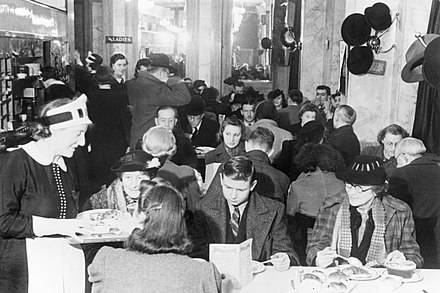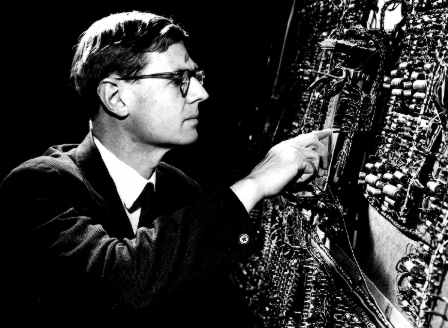| LEO - Lyons Electronic Office |
| Written by Historian | |||
Page 1 of 2
J. Lyons & Co. can claim the first machine designed specifically for business use. LEO may not have been a revolutionary machine as far as its computational and logic circuitry was concerned, but the tasks that it was to tackle were quite different. While the machines of its time were producing lists of prime numbers and ballistic trajectories, it was handling orders for teacakes and figuring wage packets. J Lyons & Co - innovatorsIn twentieth century Britain J Lyons was a huge business concern that derived its profits from selling large numbers of low cost items. The company baked the bread and cakes, blended the tea and even printed the packaging needed for its products and delivered them to its own restaurants. The management structures necessary to control this operation had developed as the company grew from its small beginnings but it needed to be an innovator to survive. It was estimated that only a farthing profit was made on each of 150 million meals it served per year and the profit per item was measured in decimal fractions of a penny.
Lyons' Corner House on Coventry Street, London, 1942 The need to control costs generated an avalanche of paperwork which was dealt with by an army of clerks. But don't think of this as a haphazard system - it was an organized and as streamlined as it could be. Each waitress wrote out a bill as the customer ordered and these were returned to head office for sorting and totalling on the same day. The modern organization was the result of the appointment of graduates as management trainees - an innovation in itself. One in particular, John Simmons, a Cambridge maths graduate, revolutionized the management structure. He built a centralized but modular clerical machine to process the data. They used mechanical calculators to speed the work but to make them effective they had to adopt a decimalised currency - working in pounds and decimal fractions of a pound rather than the pounds (base 10), shillings (base 20) and pence (base 12) that was used in the UK at the time. The management of Lyons realized that the multi-base currency was a severe handicap to the use of mechanical methods of accounting and recording. They even went as far as giving £50,000 (in 1937) to the Decimal Association to further the cause of a change to decimalisation - which didn't happen until 1971. Despite using carefully designed custom stationary for collecting the data they didn't adopt punch card technology, which was increasingly being used in the USA and making inroads into larger UK companies. The reason for this rejection of a technology that would undoubtedly have speeded things up and made them more accurate and cost effective seems to have been that it was viewed as a temporary solution and not worth using. Lyons was already thinking of something more sophisticated and more complete. In 1947 two senior managers from Lyons,Oliver Standingford and Raymond Thompson, went on a tour of the USA to see the developments that were happening in electronic calculators. At the last minute they heard some very general details of the ENIAC project which had been a closely kept secret. ENIAC is generally regarded as the first computer - but it was huge, slow and unreliable. It used thousands of valves and enough power for a small town. They didn't manage to see ENIAC but they did find out a lot about current computer technology and they returned enthused about the idea of using an "electronic brain" to automate the data processing at Lyons. At the time this idea would, and probably should, have been rejected by any company not already up to its elbows in electronics. But the Lyons management was so structured that it was already a computerized system but lacking the computer. It was clear that with the right hardware it could all be made to work and the benefits were obvious. It must have seemed just a matter of time before it all became possible and Lyons decided they didn't want to wait. Funding for EDSACWhile in the USA they learned that a more advanced version of the ENIAC was under construction by Douglas Hartree and Maurice Wilkes at Cambridge. The Lyon's board, in 1947, decided to donate £3000 to the project in return for information which would help with their own project. Along with the donation came Ernest Lenaerts, a Lyon's clerk who had learned all about high speed electronics during the war. He was seconded to Cambridge for 12 months during which he learned a great deal about EDSAC and wrote a long report that explained exactly how it worked. You might think that he would be regarded as a "spy in the camp" but the Cambridge researchers were very willing to help and surprisingly thought of the loan of Lenaerts as being as valuable as the money! John PinkertonThe project was underway but it needed a leader. Lyons placed an advertisement in the periodical Nature, which didn't mention who the job was with and didn't make it clear that it was all about computers. After all who at the time would have recognized the job title! Dr John Pinkerton answered the ad. Maurice Wilkes had tipped him off that it might well be Lyons looking for people for their computer project.
Dr John Pinkerton (1919-1997) Pinkerton had worked on radar during the war and returned to Cambridge to do research into ultrasonics. While there he heard the lecture given by Hartree who had been to the US and seen the computing revolution that was in progress - he thought it was interesting but saw no possibility of getting involved. In his last year he applied for 20 or more jobs but became increasingly choosy. However, because he was due to be married he felt that a job was essential! Lyons arranged a carefully planned interview that lasted a whole day. They showed him the existing manual data processing methods in action and explained their plans for a fully engineered version of the EDSAC - which you have to remember wasn't at that point actually working. It all sounded a little crazy but, as Pinkerton said, "great fun"! The advert in Nature had stated the annual salary as £600. He took the job at a salary of £900 per annum - having asked for £800. <ASIN:1841151858> <ASIN:0077092368> |
|||
| Last Updated ( Thursday, 27 February 2020 ) |


